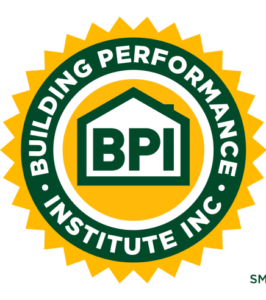There are a few different ways to use this process to condition a home. Currently, these are the most important distinctions:



Central Split Heat Pump Ducted Mini Split Heat Pump Ductless Mini Split Heat Pump

At first glance, it looks like a furnace/AC combo. But there is no gas being burned here. A refrigerant line runs from the outdoor condenser to a coil inside the air handler, which is connected to a duct system.
Ducted Mini Split Heat Pump (top right)
Similar setup to that described above, but we’re using a mini split unit and connecting it to a duct system. It’s smaller, quieter, and in many cases more efficient. It uses the small condenser shown on the bottom right.
Ductless Mini Split Heat Pump (bottom left)
Again, similar – this is a mini split unit with no duct system. The air handler simply blows air directly into the home. Very efficient for conditioning separate zones. Multiple air handlers can connect to the same condenser.
How They Work

- Evaporation absorbs energy.
- Condensation releases energy.
- Radiators with air moving through them transfer energy quickly.
Historically, there have been two arguments against heat pumps: their cost, and the fact that electricity is more expensive than gas. But now that they are comparable in price, and with the rise of solar power, it has become very clear that heat pumps are the future of the HVAC industry.
Too Many Efficiency Ratings – Simplify, Please
The efficiency of an air conditioner or heat pump is measured differently than that of a furnace. By definition, A furnace can never be more than 100% efficient – because it’s creating all the heat it’s using. The efficiency of a heat pump, however, doesn’t have a hard limit. Heat pumps don’t create heat, or magically make it disappear – they simply transfer it. Modern equipment can reach efficiency levels of 300% or higher. They don’t put that number on the box, though. Instead, you’ll see a variety of acronyms.- HSPF – Heating Seasonal Performance Factor Ratio of heating output to electricity consumed, over a typical heating season. Units are BTUs/watt-hours.
- SEER – Seasonal Energy Efficiency Ratio Ratio of cooling output to electricity consumed, over a typical cooling season. Units are BTUs/watt-hours.
- EER – Energy Efficiency Ratio Ratio of cooling output to electricity consumed, with set parameters (indoor/outdoor temperature, humidity). Again, units are BTU/watt-hours.
This number, known as the COP, or Coefficient of Performance, is a direct representation of output/input energy. So in our example, with an EER rating of 11, you’re bringing in about 3.2 times as much energy as you’re using to do it. That’s over 300% efficient. That is awesome.
Quality Installation and Correct equipment Sizing/ Duct Design are still just as important as before
While the technology has improved drastically, the other side of the industry – that is, the installation and implementation of that technology – has been slower to change its ways. Equipment oversizing and poor duct design continues to be an efficiency problem, even in brand new systems. The overall efficiency of the distribution system can be quantified, using a test we call Total Delivered Performance. This is the same concept as the COP described above, but applied to the entire system instead of just the heating/cooling unit. In other words, it is the total energy coming out of the supply registers (measured via temperature and airflow) compared to the total energy put into the system (measured at gas and/or electrical meters). We don’t have a lot of data on this yet, but we know enough to say that the average house is probably under 50%. Note that this does not take into account any losses incurred after the air is delivered, such as building air leakage, and conductive loss to outside. For example, if you are delivering very hot air because your furnace is too powerful, that air will rise to the ceiling quickly. It will create a positive pressure up high, and a relatively negative pressure at the floor. If your floor and ceiling are leaky, that air will leave the house very quickly. And the greater the temperature difference between inside and out (and the poorer the insulation), the faster the energy will be conducted out of the house.It turns out that the losses due to having a poor distribution system, an oversized unit, high building leakage and poor insulation, are many, many times more significant than the efficiency rating of the equipment itself. New technology is neat, but there’s no substitute for thorough testing and measuring, proper engineering, and good old hard work.
How do Heat Pumps relate to solar? – Net Zero Energy (NZE)
Simple and beautiful concept. If you have a well installed/designed heat pump system, you can then install solar PV to offset the huge majority of your PGE Utility bill. You completely eliminate natural gas home heating usage and have highly efficient electric heating instead. Your remaining PGE bill will likely then just be a little cooking (if you have gas cooking), water heating and maybe a gas dryer. This generally will only amount to a~$20-$30/month total utility bill. Net Zero Energy (NZE) is the concept where you are producing as much energy as you are consuming. You can either be 100% NZE, by installing electric cooking and heat pump water heating, or just stick with ~80-90% NZE. Either is a great and we’ve done this with many past projects (both existing homes and new construction) with great success. Heat pumps are the inevitable way we are heading. As the ambitious CA legislature (SB 350) progresses, heat pumps will be the only way to reach these goals. CA’s energy is coming more and more from renewable sources, making your heat pump system more and more “green” as time goes on.If you want to upgrade your home this summer, give us a call at (925) 363-4498 or e-mail kyle@epbuilders.com to schedule a whole house energy assessment.













